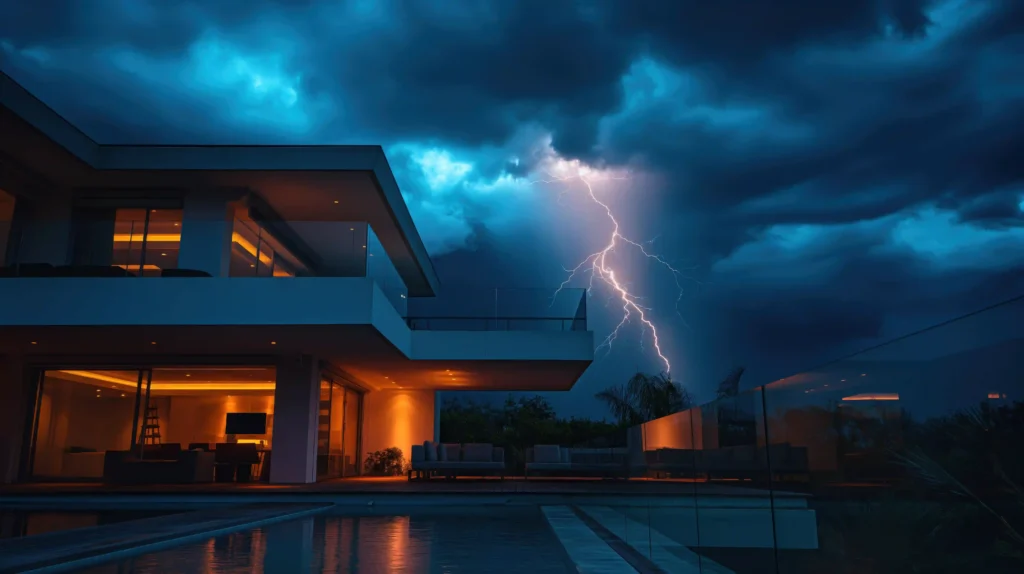
How to Design a Lightning Protection System for Industrial Buildings
Lightning strikes have the potential to cause catastrophic losses for industrial operations since they can cause equipment malfunctions, fires, and even fatalities. For uninterrupted operations, priorities concerning safety require a well-designed Lightning Protection System to be integral, not optional.
In this blog, we explain the logic and steps involved in creating a lightning protection system specific to industrial structures. Given Kerala’s heavy rainfall and frequent thunderstorms, knowing how to design a lightning protection system is essential whether you’re constructing a new facility or renovating an old one.
1. Understand the Risk
Before employing an LPS, perform a Lightning Risk Assessment with the following criteria:
Geographical position concerning structures of significance like tall trees
Occupancy and operations criticality
Structure, its materials, and its type
Building height and location
Features of electrical and electronic equipment housed within
Risk evaluation can be done accurately using guidelines like IEC 62305 or NFPA 780.
2. Identify the Main Components of a Lightning Protection System
An LPS comprises three main components:
a) Air Termination System (ATS):
Before the lightning strike reaches the building, it is captured.
In order to prevent strikes on rooftops, chimneys, tanks, and even towers, lightning rods, also known as air terminals, are positioned strategically.
Mesh or conductor networks are frequently used on larger rooftops.
b) Down Conductors:
Safely direct the lightning current from the ATS to the ground.
Provide a direct vertical path to reduce impedance.
Utilize multiple down conductors to ensure safe current disposition.
c) Earth Termination System (ETS):
This system directs lightning energy dissipation into the earth.
ETS employs the use of ground rods, ground plates, and ring earth electrodes.
The earth resistance value should be below ten ohms.
3. Follow Proper Layout and Design Guidelines
Employ Faraday Caging for very sensitive structures (conductive mesh surrounding the structure).
Spacing for the down conductors is 10 to 20 meters.
Eliminate sharp bends along the conductors.
Bond all metallic structures and cable trays to pipes and ducts to avert flashover.
Add equipotential bonding for connecting grounding systems and thus remove hazardous potential differences.
4. Integrate Surge Protection Devices (SPDs)
Lightning strikes pose the threat of transient overvoltages, which could damage delicate electronics.
SPDs need to be installed at the following locations:
Main electrical panels
Communication and data lines
Control systems
SPDs Type 1, Type 2, and Type 3 should be appropriately used according to location and sensitivity.
5. Consider Structural Materials and Roof Layout
While metal roofs enhance dispersion, they require terminals.
Protective measures also apply to rooftop equipment like HVAC units and chimneys.
Flammable zones require special boundaries and enhanced bonding.
6. Documentation and Compliance
The design must adhere to local or national norms, NFPA 780, UL 96A, and IS/IEC 62305.
It is necessary to maintain installation reports, soil resistance logs, and detailed drawings.
7. Routine Testing and Servicing
Conduct annual inspections of the lightning protection systems (LPS).
Conduct tests of the earth resistance values.
Check for signs of corrosion, mechanical damage, or loose connections.
Make component or parts modifications as needed.
Conclusion
An industrial building lightning protection system cannot be developed and then used universally.Protection against lightning should be based on the layout of the structure and the surrounding environment, particularly in regions like Kerala which are prone to tropical thunderstorms.
Implementing a good lightning protection system in Kerala not only protects physical assets and facilities, but also protects personnel and enables the continuation of key business functions. Industrial facilities can be protected from the wrath of nature using lightning capture devices, safe current dissipation systems, and surge protectors.

